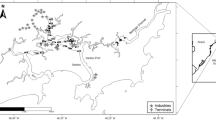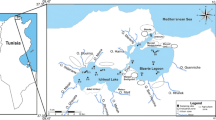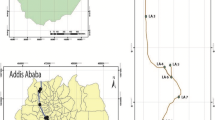Abstract
The mineralogical and geochemical characterization of sediments of the Reconquista River allows analyzing the geochemical partition of trace elements in one of the most polluted water courses of Argentina. The low dissolved oxygen and high ammonia contents, together with the high chemical oxygen demand, attest to the poor water quality. Ammonia, Cd and Cu content in surficial water exceeds the maximum guidelines for freshwater in Argentina. The recent sediments of the uppermost bed are enriched in organic matter (OM), sulfur, Zn, Cu and Pb. The enrichment factor is moderate, and the geoaccumulation index (Igeo) for Cu and Pb indicates uncontaminated to moderately contaminated sediments. The positive and significant correlation between As, Cr, Pb and Zn with the iron content suggests that their retention is controlled by the amount of iron oxy (hydr)oxides in the sediments, probably combined with the silt + clay abundance. In comparison with its tributary, the Las Catonas Stream, the Reconquista River, has less OM and trace elements in the sediments and more dissolved trace elements in the interstitial water. We interpret that OM is the main sorbent of the trace element. In the absence of OM, the iron oxy (hydr)oxides and the silt + clay fraction are a less efficient substitute. Consequently, the interstitial waters of the Reconquista River are enriched in these elements. Therefore, minor changes in the environmental conditions may generate significant release of hazardous trace elements from the sediments to the interstitial water and, in turn, to the surficial water of the river. As most of the big cities and the agricultural activities of Argentina are developed on the loessic substrate, the understanding of its interaction with polluted waters is crucial.




Similar content being viewed by others
Availability of data and materials
Any additional data will be available as required.
References
Ahmed, F., Bibi, M. H., Monsur, M. H., & Ishiga, H. (2005). Present environment and historic changes from the record of lake sediments, Dhaka City, Bangladesh. Environmental Geology, 48(1), 25–36.
Bergaya, F., & Lagaly, G. (2013). Handbook of clay science. Elsevier.
Borovec, Z. (2000). Elements in size-fractionated bottom sediments of the Elbe River in its Czech part. Aquatic Sciences, 62, 232–251.
Brunauer, S., Emmett, P. H., & Teller, E. (1938). Gases in multimolecular layers. Journal of the American Chemical Society, 60(1), 309–319.
Bufflap, S., & Allen, H. (1995). Sediment pore water collection methods for trace metal analysis: A review. Water Research, 29(1), 165–177. https://doi.org/10.1016/0043-1354(94)E0105-F
Burton, G. A. J. (2002). Sediment quality criteria in use around the world. Limnology, 3(2), 65–76. https://doi.org/10.1007/s102010200008
Canavan, R. W., Van Cappellen, P., Zwolsman, J. J. G., van den Berg, G. A., & Slomp, C. P. (2007). Geochemistry of trace metals in a fresh water sediment: Field results and diagenetic modeling. Science of the Total Environment, 381(1–3), 263–279. https://doi.org/10.1016/j.scitotenv.2007.04.001
Cantera, C. G. (2019). Geoquímica y procesos de intercambio de fosfatos en la interfaz sedimento/agua en el río Reconquista y el arroyo Las Catonas. Universidad de Buenos Aires.
Cantera, C. G., Scasso, R. A., Tufo, A., Villalba, L. B., & dos Santos Afonso, M. (2018). Mobility of trace elements between the river water, the sediments, and the pore water of Las Catonas Stream, Buenos Aires Province, Argentina. Environmental Earth Sciences, 77(535), 1–10. https://doi.org/10.1007/s12665-018-7699-5
Castro, L. N., Rendina, A. E., & Orgeira, M. J. (2018). Assessment of toxic metal contamination using a regional lithogenic geochemical background, Pampean area river basin, Argentina. Science of the Total Environment, 627, 125–133. https://doi.org/10.1016/j.scitotenv.2018.01.219
Cataldo, D., Colombo, J. C., Boltovskoy, D., Bilos, C., & Landoni, P. (2001). Environmental toxicity assessment in the Paraná river delta (Argentina): Simultaneous evaluation of selected pollutants and mortality rates of Corbicula fluminea (Bivalvia) early juveniles. Environmental Pollution, 112(3), 379–389. https://doi.org/10.1016/S0269-7491(00)00145-7
Chamley, H. (1989). Clay sedimentology. Berlin: Springer. https://doi.org/10.1007/978-3-642-85916-8
Depetris, P. J., & Pasquini, A. I. (2007). The geochemistry of the Paraná River: An overview. The Middle Paraná River: Limnology of a Subtropical Wetland. https://doi.org/10.1007/978-3-540-70624-3_6
Du, Q., Sun, Z., Forsling, W., & Tang, H. (1997). Adsorption of copper at aqueous illite surfaces. Journal of Colloid and Interface Science, 187(1), 232–242. https://doi.org/10.1006/jcis.1996.4676
Fakour, H., & Lin, T. F. (2014). Experimental determination and modeling of arsenic complexation with humic and fulvic acids. Journal of Hazardous Materials, 279, 569–578. https://doi.org/10.1016/j.jhazmat.2014.07.039
Fan, Q., He, J., Xue, H., Lü, C., Liang, Y., Saruli, Sun, Y., & Shen, L. (2007). Competitive adsorption, release and speciation of heavy metals in the Yellow River sediments, China. Environmental Geology, 53(2), 239–251. https://doi.org/10.1007/s00254-007-0638-5
Ferraro, S. A., Curutchet, G., & Tasat, D. R. (2012). Bioaccessible heavy metals-sediment particles from Reconquista River induce lung inflammation in mice. Environmental Toxicology and Chemistry, 31(9), 2059–2068. https://doi.org/10.1002/etc.1911
Folk, R. L., Andrews, P. B., & Lewis, Dw. (1970). Detrital sedimentary rock classification and nomenclature for use in New Zealand. New Zealand Journal of Geology and Geophysics, 13(4), 937–968.
Fonseca, R., Pinho, C., & Oliveira, M. (2016). The influence of particles recycling on the geochemistry of sediments in a large tropical dam lake in the Amazonian region, Brazil. Journal of South American Earth Sciences, 72, 328–350.
Gibbs, R. J. (1970). Mechanisms controlling world water chemistry. Science, 170(3962), 1088–1090.
Goldberg, S. (2002). Competitive adsorption of arsenate and arsenite on oxides and clay minerals. Soil Science Society of America Journal, 66(2), 413–421. https://doi.org/10.2136/sssaj2002.4130
Goldsmith, J. R., Graf, D. L., & Heard, H. C. (1961). Lattice constants of the calcium magnesium carbonates. American Mineralogist, 46(3-4_Part_1), 453–459.
Gonzalez Bonorino, F. (1966). Soil clay mineralogy of the Pampa plains, Argentina. Journal of Sedimentary Research, 36(4), 1026–1035.
Groen, J. C., Peffer, L. A. A., & Pérez-Ramírez, J. (2003). Pore size determination in modified micro- and mesoporous materials. Pitfalls and limitations in gas adsorption data analysis. Microporous and Mesoporous Materials, 60(1–3), 1–17. https://doi.org/10.1016/S1387-1811(03)00339-1
Hach. (2021). Water analysis handbook. Retrieved 15 March, 2021, from https://www.hach.com/wah.
Herkovits, J., Perez-Coll, C. S., & Herkovits, F. D. (1996). Ecotoxicity in the Reconquista River, province of Buenos Aires, Argentina: A preliminary study. Environmental Health Perspectives, 104(2), 186–189.
Hmamou, M., Sbihi, K., Ammary, B., & Bellaouchou, A. (2020). Study of chromium adsorption by iron hydroxide. Materials Today: Proceedings, 24, 52–59. https://doi.org/10.1016/j.matpr.2019.07.528
Instituto Nacional de Tecnología Agropecuaria (INTA). (1990). Atlas de Suelos de la República Argentina. (p. TY 83–85). Buenos Aires, Argentina.
Instituto Nacional del Agua (INA). (1998). Estudio para la Determinación de Valores Guía, Criterios de Calidad y Procedimientos para el Manejo de Sedimentos a Dragar. (Administración General de Puertos S.E.). Buenos Aires, Argentina.
Kuila, U., & Prasad, M. (2013). Specific surface area and pore-size distribution in clays and shales. Geophysical Prospecting, 61(2), 341–362. https://doi.org/10.1111/1365-2478.12028
Li, F., Guo, H., Zhou, X., Zhao, K., Shen, J., Liu, F., & Wei, C. (2017). Impact of natural organic matter on arsenic removal by modified granular natural siderite: Evidence of ternary complex formation by HPSEC-UV-ICP-MS. Chemosphere, 168, 777–785. https://doi.org/10.1016/j.chemosphere.2016.10.135
Lin, Z., & Puls, R. W. (2000). Adsorption, desorption and oxidation of arsenic affected by clay minerals and aging process. Environmental Geology, 39(7), 753–759. https://doi.org/10.1007/s002540050490
Loez, C. R., & Topalián, M. L. (1999). Use of algae for monitoring rivers in Argentina with a special emphasis for the Reconquista river (region of Buenos Aires). Use of Algae for Monitoring Rivers, 3, 72–83.
Lombardo, R. J., O’Farrell, I., & dos Santos Afonso, M. (2010). Spatial and temporal ion dynamics on a complex hydrological system: The lower Luján river (Buenos Aires, Argentina). Aquatic Geochemistry, 16(2), 293–309. https://doi.org/10.1007/s10498-009-9064-5
Mondino, E. (2007). Informe Especial Cuenca del río Reconquista. Primera Parte.
Moore, D. M., & Reynolds, R. C. (1997). X-ray diffraction and the identification and analysis of clay minerals. Oxford University Press.
Müller, G. (1979). Schwermetalle in Den Sedimenten Des Rheins - Veranderungen Seit 1971. Umsch. Wissensch. Techn., 79(24), 778–783.
Nader, G. M. (2015). Evaluación de la calidad del agua en el río urbano. Universidad Nacional de San Martín.
Nicolli, H. B., Bundschuh, J., del C. Blanco, M., Tujchneider, O. C., Panarello, H. O., Dapeña, C., & Rusansky, J. E. (2012). Arsenic and associated trace-elements in groundwater from the Chaco-Pampean plain, Argentina: Results from 100years of research. Science of the Total Environment, 429, 36–56. https://doi.org/10.1016/j.scitotenv.2012.04.048
Omotoso, O. E., & Mikula, R. J. (2004). High surface areas caused by smectitic interstratification of kaolinite and illite in Athabasca oil sands. Applied Clay Science, 25(1–2), 37–47.
Ossana, N. A., Baudou, F. G., Castañé, P. M., Tripoli, L., Soloneski, S., & Ferrari, L. (2019). Histological, Genotoxic, and biochemical effects on Cnesterodon decemmaculatus (Jenyns 1842) (Cyprinodontiformes, Poeciliidae): Early response bioassays to assess the impact of receiving waters. Journal of Toxicology, 2019, 1–13. https://doi.org/10.1155/2019/4687685
Ossana, N. A., Castañé, P. M., & Salibián, A. (2013). Use of Lithobates catesbeianus tadpoles in a multiple biomarker approach for the assessment of water quality of the Reconquista river (Argentina). Archives of Environmental Contamination and Toxicology, 65(3), 486–497.
Ossana, N. A., Eissa, B. L., Baudou, F. G., Castañé, P. M., Soloneski, S., & Ferrari, L. (2016). Multibiomarker response in ten spotted live-bearer fish Cnesterodon decemmaculatus (Jenyns, 1842) exposed to Reconquista river water. Ecotoxicology and Environmental Safety, 133, 73–81.
Pescuma, A., & Guaresmi, M. E. (1992). Proyecto de sanea miento ambiental y control de inundaciones de la cuenca del Río Reconquista. Informe final. Buenos Aires.
Porzionato, N., Tufo, A., Candal, R., & Curutchet, G. (2016). Metal bioleaching from anaerobic sediments from Reconquista River basin (Argentina) as a potential remediation strategy. Environmental Science and Pollution Research, 24(33), 25561–25570. https://doi.org/10.1007/s11356-016-6717-y
Prasanna, M. V., Chidambaram, S., Gireesh, T. V., & Ali, T. V. J. (2011). A study on hydrochemical characteristics of surface and sub-surface water in and around Perumal Lake, Cuddalore district, Tamil Nadu, South India. Environmental Earth Sciences, 63(1), 31–47. https://doi.org/10.1007/s12665-010-0664-6
Rendina, A., De Cabo, L., Arreghini, S., Bargiela, M., & Fabrizio de Iorio, A. (2001). Geochemical distribution and mobility factors of Zn and Cu in sediments of the Reconquista River, Argentina. Revista Internacional De Contaminacion Ambiental, 17(4), 187–192.
Rendina, A., & Fabrizio de Iorio, A. (2012). Heavy metal partitioning in bottom sediments of the Matanza-Riachuelo River and main tributary streams. Soil and Sediment Contamination, 21(1), 62–81. https://doi.org/10.1080/15320383.2012.636776
Rice, E. W., Baird, R. B., Eaton, A. D., & Clesceri, L. S. (2012). Standard methods for the examination of water and wastewater (p. 1496). APHA, AWWA, WPCR.
Rigacci, L. N., Giorgi, A. D. N., Vilches, C. S., Ossana, N. A., & Salibián, A. (2013). Effect of a reservoir in the water quality of the Reconquista River, Buenos Aires, Argentina. Environmental Monitoring and Assessment, 185(11), 9161–9168. https://doi.org/10.1007/s10661-013-3243-y
Rigaud, S., Radakovitch, O., Couture, R. M., Deflandre, B., Cossa, D., Garnier, C., & Garnier, J. M. (2013). Mobility and fluxes of trace elements and nutrients at the sediment-water interface of a lagoon under contrasting water column oxygenation conditions. Applied Geochemistry, 31, 35–51. https://doi.org/10.1016/j.apgeochem.2012.12.003
Rosso, J. J., Schenone, N. F., Pérez Carrera, A., & Fernández Cirelli, A. (2013). Concentration of arsenic in water, sediments and fish species from naturally contaminated rivers. Environmental Geochemistry and Health, 35(2), 201–214. https://doi.org/10.1007/s10653-012-9476-9
Rouquerol, J., Rouquerol, F., Llewellyn, P., Maurin, G., & Sing, K. S. W. (2013). Adsorption by powders and porous solids: Principles. Elsevier.
Saeedi, M., Hosseinzadeh, M., & Rajabzadeh, M. (2011). Competitive heavy metals adsorption on natural bed sediments of Jajrood River, Iran. Environmental Earth Sciences, 62(3), 519–527. https://doi.org/10.1007/s12665-010-0544-0
Saidian, M., Godinez, L. J., & Prasad, M. (2016). Effect of clay and organic matter on nitrogen adsorption specific surface area and cation exchange capacity in shales (mudrocks). Journal of Natural Gas Science and Engineering, 33, 1095–1106.
Salibián, A. (2006). Ecotoxicological assessment of the highly polluted Reconquista River of Argentina. In G. W. Ware, H. N. Nigg, & D. R. Doerge (Eds.), Reviews of environmental contamination and toxicology (pp. 35–65). Springer. https://doi.org/10.1007/0-387-30638-2_2
Sharma, P., Ofner, J., & Kappler, A. (2010). Formation of binary and ternary colloids and dissolved complexes of organic matter, Fe and As. Environmental Science and Technology, 44(12), 4479–4485. https://doi.org/10.1021/es100066s
Sierra, L., Cacciabue, L., Dietrich, S., Weinzettel, P. A., & Bea, S. A. (2016). Arsenic in groundwater and sediments in a loessic aquifer, Argentina. In Arsenic research and global sustainability—proceedings of the 6th international congress on arsenic in the environment, AS 2016, (June) (pp. 92–93). https://doi.org/https://doi.org/10.1201/b20466-45.
Simex, S. A., & Helz, G. R. (1981). Regional geochemistry of trace elements in Chesapeake Bay. Environmental Geology, 3(6), 315–323.
Sing, K. S. W. (1985). Reporting physisorption data for gas/solid systems with special reference to the determination of surface area and porosity (Recommendations 1984). Pure and Applied Chemistry, 57(4), 2201–2218. https://doi.org/10.1351/pac198557040603
Stumm, W., & Morgan, J. J. (1996). Aquatic chemistry: Chemical equilibria and rates in natural waters. Wiley.
Teruggi, M. E. (1957). The nature and origin of argentine loess. Journal of Sedimentary Petrology, 27(3), 322–332. https://doi.org/10.1306/74d706dc-2b21-11d7-8648000102c1865d
Toledo, M. J. (2011). El legado lujanense de ameghino: Revisión estratigráfica de los depósitos pleistocenos- holocenos del valle del río luján en su sección tipo. registro paleoclimático en la pampa de los estadios OIS 4 al OIS 1. Revista De La Asociacion Geologica Argentina, 68(1), 121–167.
Tufo, A. E. (2013). Retención de contaminantes metálicos y arsénico por oxo(hidr)óxidos de hierro puros y sustituidos. Universidad de Buenos Aires.
Tufo, A. E., Porzionato, N. F., & Curutchet, G. (2018). Effects of pollution and bioleaching process on the mineral composition and texture of contaminated sediments of the Reconquista River, Argentina. Environmental Science and Pollution Research, 25(22), 21368–21384. https://doi.org/10.1007/s11356-017-0484-2
Tufo, A. E., Vázquez, S., Porzionato, N. F., Grimolizzi, M. C., Prados, M. B., Sica, M., & Curutchet, G. (2021). Contamination alters the physicochemical and textural characteristics of clays in the sediments of the peri urban Reconquista River, affecting the associated indigenous microorganisms. Minerals, 11(3), 242.
Uddin, M. K. (2017). A review on the adsorption of heavy metals by clay minerals, with special focus on the past decade. Chemical Engineering Journal, 308, 438–462. https://doi.org/10.1016/j.cej.2016.09.029
Unda-Calvo, J., Ruiz-Romera, E., de Vallejuelo, S.F.-O., Martínez-Santos, M., & Gredilla, A. (2019). Evaluating the role of particle size on urban environmental geochemistry of metals in surface sediments. Science of the Total Environment, 646, 121–133.
USEPA. (2019). Methods approved to analyze drinking water samples to ensure compliance with regulations. Retrieved 15 March, 2021, from https://www.epa.gov/dwanalyticalmethods.
Villarroel Rocha, J., Barrera, D., & Sapag, K. (2011). Improvement in the pore size distribution for ordered mesoporous materials with cylindrical and spherical pores using the Kelvin equation. Topics in Catalysis, 54(1–4), 121–134.
Villarroel Rocha, J., Barrera, D., & Sapag, K. (2014). Introducing a self-consistent test and the corresponding modification in the Barrett, Joyner and Halenda method for pore-size determination. Microporous and Mesoporous Materials, 200, 68–78.
Volpedo, A., & Fernández Cirelli, A. (2013). El Lago Chasicó: similitudes y diferencias con las lagunas pampásicas. Augmdomus, 5(1), 1–18.
Wachs, B. (1998). A qualitative classification for the evaluation of the heavy metal contamination in river ecosystems. Internationale Vereinigung Für Theoretische Und Angewandte Limnologie: Verhandlungen, 26(3), 1289–1294.
Wetzel, R. G. (2001). Limnology (3rd ed.). Academic Press. https://doi.org/10.1017/CBO9781107415324.004
Zárate, M. A. (2003). Loess of southern South America. Quaternary Science Reviews, 22(18–19), 1987–2006. https://doi.org/10.1016/S0277-3791(03)00165-3
Acknowledgements
The authors acknowledge the financial support of the Consejo Nacional de Investigaciones Científicas y Técnicas (CONICET; PUE 2555/16), Ministerio de Educación de la Nación (SPU 165-2014) and Universidad de Buenos Aires (UBA; UBACyT 20020130100591BA). The authors would also like to thank Carlos E. Alli and Laura B. Villalba (SENASA) for helping in AAS trace element determination in water samples; Héctor Villar and GeoLab Sur for the TOC determination in sediments samples; Marcelo J. Toledo for his assistance in the stratigraphic characterization of the Pleistocene-Holocene sediments; Germán Segado and his team from the Municipalidad de Moreno of Provincia de Buenos Aires for their logistic support; “Río Reconquista” Project members for their collaboration in water and sediments sampling.
Funding
This work was made with the financial support of the Consejo Nacional de Investigaciones Científicas y Técnicas (CONICET; PUE 2555/16), Ministerio de Educación de la Nación (SPU 165-2014) and Universidad de Buenos Aires (UBA; UBACyT 20020130100591BA).
Author information
Authors and Affiliations
Contributions
CGC, RAS and MdSA designed research; CGC, AET and RAS performed research; CGC, AET, RAS and MdSA analyzed and interpreted data; and CGC, AET, RAS and MdSA wrote the paper and revised the manuscript critically.
Corresponding author
Ethics declarations
Conflict of interest
No conflict of interest has been declared by the authors.
Additional information
Publisher's Note
Springer Nature remains neutral with regard to jurisdictional claims in published maps and institutional affiliations.
Supplementary Information
Below is the link to the electronic supplementary material.
Rights and permissions
About this article
Cite this article
Cantera, C.G., Tufo, A.E., Scasso, R.A. et al. Geochemical characterization and the assessment of trace element retention in sediments of the Reconquista River, Argentina. Environ Geochem Health 44, 729–747 (2022). https://doi.org/10.1007/s10653-021-00970-7
Received:
Accepted:
Published:
Issue Date:
DOI: https://doi.org/10.1007/s10653-021-00970-7




